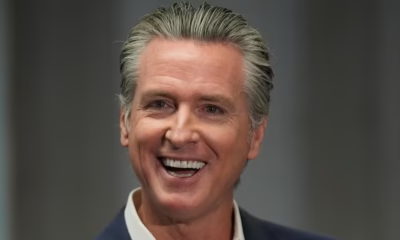World News
Donald Trump Dances His Way Into Malaysia As Asia Tour Begins With a Surprise Move That Has Everyone Talking
Former U.S. President Donald Trump kicked off his highly anticipated Asia trip in style — quite literally — as he landed in Malaysia and broke into his signature fist-pump dance, marking the start of a diplomatic journey that could reshape trade talks with China’s Xi Jinping.

It was not the handshakes, speeches, or flashing cameras that stole the show when Donald Trump landed in Kuala Lumpur on October 26 — it was his unmistakable fist-pump dance, the same move that became a viral highlight during his 2024 presidential campaign.
The former president arrived for the 47th ASEAN Summit, a three-day event running from October 26 to October 28, attended by leaders from across Southeast Asia. The crowd in Malaysia’s capital city erupted in cheers and curiosity as Trump, dressed in a dark suit and red tie, smiled, waved, and broke into his trademark rhythm — a gesture many interpreted as a show of confidence on the global stage.
ALSO READ : Rockets Guard Fred VanVleet Tears ACL and Likely to Miss 2025-26 Season
“Trump Dance Diplomacy” Steals the Spotlight
While critics on X (formerly Twitter) called it “typical Trump showmanship,” supporters praised the moment as a reflection of his charisma and unfiltered style. One user joked, “When Trump’s dance says more about diplomacy than a press statement ever could.”
The lighthearted moment quickly trended online, with hashtags like #TrumpInMalaysia and #TrumpDance gaining traction within hours of his arrival.
But behind the viral moment, Trump’s trip to Asia carries far greater weight — politically and diplomatically.
A Strategic Start to His Asia Tour
According to Reuters, Trump’s first stop in Malaysia includes witnessing a historic ceasefire deal between Thailand and Cambodia, which he claims to have personally helped broker. “We made something happen that people thought was impossible,” Trump reportedly said before boarding his plane.
The ceasefire is being hailed as a potential turning point in easing border tensions between the two Southeast Asian nations. Trump, ever eager to highlight his global negotiating prowess, described the event as “a victory for peace and prosperity in Asia.”
Next Stops: Japan and South Korea
After wrapping up meetings in Kuala Lumpur, Trump will head to Tokyo and later to Seoul, where he is scheduled to meet Chinese President Xi Jinping on October 30.
The meeting between the two leaders is expected to focus on trade — a subject Trump has long claimed mastery over. Speaking to reporters earlier this month, he said, “I think we’ll make a deal. They threatened us with rare earths, and I threatened them with tariffs.”
His confident remark hinted at his typical negotiation strategy — equal parts bravado and brinkmanship. However, Trump also left room for uncertainty, adding that he might leave Asia “without a deal if it’s not good for America.”

Trade Talks, Tariffs, and Tension
During his 2024 campaign and throughout his presidency, Trump frequently sparred with China over trade, currency manipulation, and intellectual property theft. Analysts believe his upcoming meeting with Xi could either mark a thaw in U.S.-China relations or rekindle an old rivalry that shaped global economics during his administration.
Political analyst Ian Bremmer noted that Trump’s Asia visit appears designed to project “confidence, control, and comeback power” — especially as he reestablishes his global footprint post-presidency.
Meanwhile, The White House has not issued an official statement on Trump’s tour, which is being described by his aides as a “private diplomatic initiative.” Still, the line between private and political often blurs when Trump is involved.
ASEAN 47th Summit: Regional Focus
The ASEAN Summit itself — the 47th in the organization’s history — brings together key leaders from the Association of Southeast Asian Nations to discuss economic cooperation, security, and climate challenges. Trump’s attendance, according to local media, has injected “celebrity energy” into an otherwise formal gathering.
Malaysian Prime Minister Anwar Ibrahim welcomed Trump personally, saying the U.S. figure’s participation “symbolizes ongoing dialogue between Southeast Asia and global powers.”
Social Media Frenzy and Global Headlines
Clips of Trump’s arrival and his signature dance went viral across platforms. On TikTok, one video showing Trump stepping off the plane with his familiar music playing in the background crossed 5 million views within hours.
Political observers noted that the “dance moment” overshadowed other headlines from the Summit, proving once again Trump’s uncanny ability to dominate media cycles wherever he goes.
One commentator on CNN International remarked, “When Trump dances, the world watches — not because it’s a performance, but because it’s a statement. It says, ‘I’m back, and I’m still in control of the narrative.’”
A “Deal or No Deal” Endgame
Trump’s upcoming meeting with Xi Jinping on October 30 in South Korea could define the legacy of his return to international diplomacy. Whether it ends in a symbolic handshake or a fiery trade standoff, the world will be watching closely.
As Trump told reporters before boarding Air Force One: “I like Xi. I think we’ll make a deal — but if not, that’s fine too. I’ve walked away before, and maybe I’ll do it again.”
Love him or hate him, Trump’s blend of unpredictability and showmanship continues to make him one of the most watched figures in global politics. And as his latest Asia tour shows — sometimes diplomacy begins with a dance.
World News
Israel Strikes Gaza City After Ceasefire Collapses — Netanyahu Says “Powerful Response” Was Needed
Israeli Prime Minister Benjamin Netanyahu ordered “immediate and powerful strikes” on Gaza City after accusing Hamas of breaching a U.S.-brokered truce — plunging the region back into turmoil.

Tensions in the Middle East have once again reached a boiling point. Late Tuesday night, Benjamin Netanyahu ordered the Israel Defense Forces (IDF) to conduct large-scale airstrikes in Gaza City, following what Israel described as “blatant violations” of the ceasefire by Hamas.
“Following security consultations, the Prime Minister instructed the military echelon to carry out powerful strikes in the Gaza Strip immediately,” Netanyahu’s office announced in a statement shared on X.
According to Reuters, the order came after Hamas allegedly attacked Israeli positions near Rafah and failed to return hostage remains as agreed under the ceasefire.
Ceasefire Terms in Tatters
The fragile truce, brokered with mediation from Egypt, Qatar, and the United States, was designed to allow humanitarian aid into Gaza and enable a phased hostage exchange. But Israeli officials now claim Hamas “breached multiple clauses,” reigniting hostilities.
ALSO READ : Rockets Guard Fred VanVleet Tears ACL and Likely to Miss 2025-26 Season
Hamas, through its spokesperson on Telegram, denied the accusations, stating that “Israel’s aggression is aimed at derailing peace efforts and deepening the humanitarian crisis.”
Meanwhile, Antony Blinken, the U.S. Secretary of State, urged restraint on both sides, calling for “immediate de-escalation and full humanitarian access.”
Airstrikes Rock Gaza City
Residents reported a series of explosions across Gaza City, particularly in the Al-Rimal and Al-Sabra neighborhoods. According to Al Jazeera, at least 20 Palestinians were killed in the first wave of strikes, while dozens were injured.
Human rights groups such as Human Rights Watch and Amnesty International have condemned the renewed escalation, warning of “catastrophic humanitarian consequences” if full-scale operations resume.
Israel maintains that the airstrikes were “targeted and proportionate,” aimed at Hamas command centers and rocket-launching sites.
“This is not a resumption of war — it is the enforcement of the ceasefire’s conditions,” said IDF spokesperson Rear Admiral Daniel Hagari during a press briefing.

International Reaction: A Diplomatic Tightrope
The sudden escalation has alarmed regional and global powers. The United Nations Security Council is expected to convene an emergency meeting to discuss the situation.
U.S. President Joe Biden has reportedly spoken with Netanyahu, emphasizing “the need to protect civilians and prevent further humanitarian disaster.”
European leaders, including Rishi Sunak and Emmanuel Macron, called for “mutual restraint,” while Russia and China urged an immediate cessation of hostilities and a return to the truce framework.
The Humanitarian Crisis Deepens
Even before the latest strikes, Gaza was facing one of the worst humanitarian crises in recent memory. The World Health Organization (WHO) estimates that over 70% of Gaza’s population has been displaced since the beginning of the conflict.
Medical facilities are on the brink of collapse. Doctors Without Borders reported severe shortages of anesthetics and trauma supplies, warning that a “complete blackout” in hospital operations could occur within days if fuel deliveries are halted.
Netanyahu’s Political Gamble
For Benjamin Netanyahu, the decision to resume airstrikes comes amid growing domestic criticism. Hardline members of his Likud party have demanded a more aggressive stance against Hamas, while moderates within his coalition fear international backlash.
Analysts suggest the move could also be an attempt to consolidate his political base ahead of mounting corruption trials and public dissatisfaction with the government’s handling of security and hostage negotiations.
Political analyst Barak Ravid commented on X:
“Netanyahu is walking a dangerous line — balancing domestic politics, international diplomacy, and national security. A single misstep could redefine Israel’s position in the region.”
Looking Ahead: Peace or Peril?
Diplomats from Egypt, Qatar, and the United Nations are expected to re-engage in shuttle diplomacy in the coming days to prevent a complete collapse of the ceasefire framework.
But as of now, airstrikes continue, sirens blare, and fears of a wider regional escalation — involving Hezbollah in Lebanon or Iran — are growing.
For civilians trapped in Gaza, the nightmare that briefly paused under the ceasefire appears to have returned — louder, deadlier, and more uncertain than ever.
Australia
Dozens of Sharks Cause Chaos at Gold Coast’s Snapper Rocks — ‘She’s Sharky!’ Locals Stunned by Rare Feeding Frenzy
A rare sight left surfers terrified as dozens of sharks swarmed Australia’s famous Snapper Rocks, creating a massive feeding frenzy near the shore and forcing the beach to clear out completely.

A breathtaking yet chilling moment unfolded off the shores of Snapper Rocks — one of Australia’s most iconic surfing spots — where dozens of sharks were captured on camera swarming in a frenzied hunt close to the coastline. The surreal scene left locals and surfers speechless, calling it “one of the wildest shark sightings ever recorded on the Gold Coast.”
The viral footage, which has been circulating on TikTok and X (formerly Twitter), shows dozens of sharks darting through shallow waters, some even becoming semi-beached as they chased a dense school of small fish, known as a “bait ball.”
One local surfer, Daisy Thompson, posted the clip with the chilling caption: “She’s sharky!” — words that perfectly summed up the tension on an otherwise ordinary day at Snapper Rocks.
A Surfing Paradise Turns Into a Scene from “Jaws”
On any given day, Snapper Rocks is usually packed with hundreds of surfers waiting for perfect waves. But on Tuesday, the iconic break looked eerily empty. According to eyewitnesses, the combination of poor surf conditions and the sudden shark activity kept everyone out of the water.
“It’s usually shoulder to shoulder out there,” one local told Daily Global Diary. “But when the word ‘sharks’ spreads through the crowd, everyone’s gone in seconds.”
Videos posted by beachgoers show fins cutting through the shallows just meters from the sand, with the sharks — estimated to be between 1 to 2.5 meters long — lunging at the fish swarm.

Marine experts believe these predators were most likely spinner sharks or blacktip sharks, both common along the Queensland coastline, known for high-speed spinning attacks during feeding frenzies.
What Is a Bait Ball and Why Sharks Love It
The phenomenon at Snapper Rocks was triggered by what scientists call a bait ball — a tight, spherical formation created by schools of small fish as a defense mechanism against predators. Unfortunately, this “safety in numbers” tactic also makes them a prime target for large predators like sharks, dolphins, and seabirds.
Marine biologist Dr. Vanessa Pirotta, from Macquarie University, explained that bait balls are common during warm-water months in Queensland and New South Wales. “They form when schools of fish are cornered, and predators like sharks see it as an open buffet,” she said.
Such feeding events often result in temporary beach closures, as authorities urge swimmers and surfers to stay clear of the area until the predators move on.
Locals Left in Awe — and Fear
While no injuries were reported, the incident has reignited long-standing discussions about shark safety along the Australian coast. Social media comments reflected a mix of fascination and fear.
One user wrote, “It’s beautiful but terrifying. Nature in full force.” Another warned, “On a serious note, this is scary — definitely do not go swimming or surfing!”
Lifeguards on the Gold Coast often monitor shark activity closely, especially during bait migrations. According to Surf Life Saving Queensland, spotting multiple sharks during such events is not rare, but the sheer number seen at Snapper Rocks this week was unusual.

Feeding Frenzies Are Natural — But Unsettling
Experts emphasize that shark feeding frenzies are natural parts of marine ecosystems. “These predators play an essential role in maintaining ocean health,” says Dr. Pirotta. “It’s a reminder that we share these waters — they are their homes first.”
Despite their fearsome reputation, sharks are rarely aggressive toward humans. According to the International Shark Attack File, shark attacks in Australia have been declining thanks to better safety measures, surveillance drones, and early warning systems.
Still, the sight of dozens of sleek fins cutting through shallow water is enough to keep even the bravest surfers on edge.
Snapper Rocks — The Jewel of the Gold Coast
Snapper Rocks, located near Coolangatta, is known worldwide as a premier surf destination. It’s the birthplace of the legendary Superbank, a series of connected sandbars that produce some of the longest and most perfect right-hand point breaks on Earth.
It regularly hosts events like the World Surf League’s Quiksilver Pro and has been surfed by icons like Mick Fanning and Stephanie Gilmore.
For a place so deeply tied to Australia’s surf culture, seeing the ocean turn into a feeding ground for dozens of sharks was surreal.
Authorities and Experts Urge Caution
Following the incident, local authorities reminded beachgoers to respect warning signs and follow lifeguard instructions. “We understand it’s tempting to get a closer look, but these are wild animals,” a spokesperson from Surf Life Saving Queensland said. “Always observe from a safe distance.”
Experts also recommend checking shark alerts through official apps before entering the water.
Nature’s Power on Full Display
The footage from Snapper Rocks serves as a stunning reminder of the raw beauty and unpredictability of the ocean. It captures a rare natural event — one that evokes both awe and caution in equal measure.
As one surfer put it: “This is their home. We’re just visitors.”
For more global updates, nature stories, and breaking news, visit our website www.DailyGlobalDiary.com.
World News
Flights Frozen at LAX for Nearly Two Hours After Staffing Shortage — What Really Happened in the Control Towers
A sudden staffing shortage in Southern California’s airspace forced the Federal Aviation Administration (FAA) to impose a temporary ground stop at Los Angeles International Airport (LAX), halting departures and causing ripple delays across California.

Travelers at Los Angeles International Airport (LAX) faced unexpected chaos on October 26, when a staffing shortage among air traffic controllers triggered a temporary ground stop, grounding flights for nearly two hours. The Federal Aviation Administration (FAA) confirmed that the disruption, which began at around 8:45 a.m. local time, was due to a lack of personnel managing Southern California’s heavily trafficked skies.
The grounding primarily impacted flights between Los Angeles and Oakland, California. According to the FAA’s Air Traffic Control System Command Center advisory, the restriction was lifted around 10:30 a.m., but not before hundreds of passengers faced mounting delays and frustration.
ALSO READ : Rockets Guard Fred VanVleet Tears ACL and Likely to Miss 2025-26 Season
“One of the Highest Shortage Levels We’ve Seen,” Says U.S. Transportation Secretary
U.S. Transportation Secretary Sean Duffy sounded the alarm even before the incident, warning on Fox News’ “Sunday Morning Futures” that air travel disruptions could worsen as air traffic controllers miss their first full paycheck amid the federal government shutdown.
“The FAA had 22 ‘triggers’ indicating shortages on October 25 — one of the highest that we’ve seen in the system since October 1,” Duffy said. His remarks now appear eerily prophetic as the LAX incident became a real-world manifestation of the stress gripping the aviation network.
Over 900 Minutes of Delays and Mounting Passenger Frustration
The FAA reported that the temporary ground stop caused over 900 total minutes of flight delays, with an average delay time of 49 minutes. Some flights were stalled for as long as 87 minutes, as passengers waited anxiously for updates.
Travelers took to social media to express their frustration. One passenger, @FlyWithSam, wrote on X (formerly Twitter): “Sat on the runway at LAX for an hour because of ‘staffing shortages.’ How are we short of people controlling planes in the world’s biggest economy?”
Another user, @AviationInsider, commented, “LAX and Oakland both hit by staffing-related hold? That’s a huge red flag for system stability.”
The Broader Problem: FAA’s Staffing Crisis
This is not an isolated incident. Aviation analysts have long warned of a looming shortage of air traffic controllers in the United States. The National Air Traffic Controllers Association (NATCA) has reported that the FAA is operating with thousands fewer certified controllers than needed to maintain peak safety and efficiency levels.
According to a 2024 report by Bloomberg, the FAA’s training backlog worsened during the COVID-19 pandemic, when lockdowns and safety protocols drastically reduced new trainee throughput. The result: a fragile system that now struggles to withstand even minor disruptions.

“The FAA workforce is exhausted,” aviation consultant John Goglia told reporters earlier this year. “They’re being asked to do more with less, and that’s not sustainable when safety is on the line.”
Ripple Effects Across California
While the FAA emphasized that the ground stop was limited to flights between Los Angeles and Oakland, its effects rippled across California’s busy air corridor. Airlines scrambled to adjust schedules, causing brief delays at nearby hubs including San Diego International Airport and San Francisco International Airport.
Though normal operations resumed around 10:30 a.m., the FAA cautioned that residual delays might persist throughout the day. “We expect some lingering delays as we get the system back on track,” the agency said in a statement.
Government Shutdown Adds to the Pressure
The timing of the incident could not have been worse. As the U.S. federal government shutdown drags on, thousands of federal employees — including those within the FAA — are either working without pay or facing uncertainty about when they’ll receive their next paycheck.
The shortage’s connection to the shutdown has raised new concerns about the safety and stability of the U.S. aviation infrastructure. President Joe Biden has yet to issue a direct statement regarding the LAX incident, but administration officials have hinted at the urgency of resolving funding issues affecting critical agencies.
Passengers Left Asking: Could This Happen Again?
While the ground stop at LAX was temporary, it has reignited fears that the U.S. aviation system is teetering on the edge of a staffing collapse. Experts warn that without swift action — including accelerated hiring, better pay, and improved work-life balance — similar shutdowns could become increasingly common.
“Even short-term disruptions can have cascading effects,” noted Henry Harteveldt, a travel industry analyst with Atmosphere Research Group. “What starts as a local staffing problem can quickly spread through national air traffic networks.”
What’s Next for the FAA?
The FAA has promised to review its internal staffing models and evaluate how scheduling gaps led to the disruption. The agency is reportedly considering temporary reassignments from lower-traffic control centers to maintain operations in critical regions like Southern California.
Meanwhile, passengers and airlines alike are hoping for stability as the busy holiday travel season approaches. “We’re doing everything we can to minimize delays and keep flights safe,” the FAA said in a follow-up advisory.
But as travelers prepare for the next wave of flights, many are left wondering if October 26 was merely an isolated scare — or a warning sign of more turbulence ahead in America’s skies.
-

 Entertainment6 days ago
Entertainment6 days agoRobert De Niro slams ‘King Donald I’ and calls Americans to rise again — says ‘we can’t let up’ against Trump’s bullying tactics
-

 Entertainment3 days ago
Entertainment3 days agoFans Can’t Believe Susan Boyle’s Stunning New Look… “She’s Unrecognizable!”
-

 Politics5 days ago
Politics5 days agoWhy Donald Trump Suddenly Ended All Trade Talks With Canada — And the Unexpected Role of Ronald Reagan
-

 Sports1 week ago
Sports1 week ago“Chasing more than a conference crown… Purdue Boilermakers set sights on national glory after historic preseason No. 1 nod”
-

 Politics5 days ago
Politics5 days agoCharlotte Train Horror: Why a Ukrainian Refugee’s Killing Has Sparked a Death Penalty Case That’s Shaking America
-

 Sports1 week ago
Sports1 week agoHistory made! Purdue Boilermakers grab first-ever No. 1 spot in USA TODAY Sports preseason men’s basketball poll — can they finally win it all?
-

 Entertainment6 days ago
Entertainment6 days agoDonald Trump fumes as Bad Bunny becomes first-ever Spanish-only Super Bowl headliner — NFL says decision was ‘carefully thought through’
-

 Politics1 week ago
Politics1 week agoPoll shocker: Donald Trump’s approval rating climbs as Americans surprisingly back a Palestinian state




























